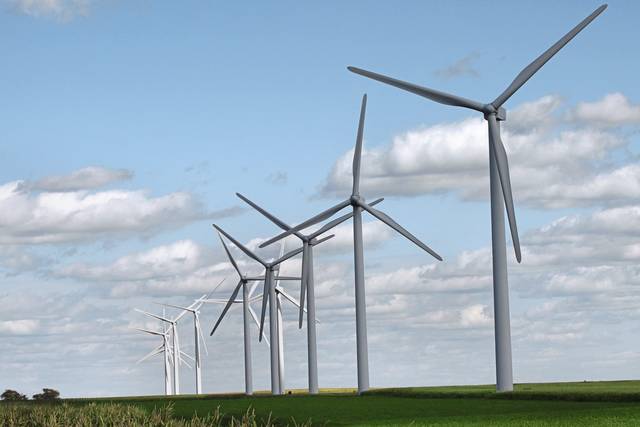https://development.triblive.com/opinion/mark-glick-on-climate-and-energy-free-fall-or-opportunity-for-western-pa/
Mark Glick: On climate and energy, free fall or opportunity for Western Pa.?

The defining feature of the Trump administration’s “America First” energy policy was the near exclusive fixation on oil and natural gas development coupled with the aggressive rollback of environmental policies and regulations associated with decarbonization. Such a status quo policy ran counter to global economic growth trends to decarbonize the electricity and transportation sectors through cost-competitive investments in renewable energy and electric vehicles (EVs).
Consider recent changes in the electricity sector for which the Energy Information Agency attributes 75% of new electricity generation in the United States to wind and solar this year, with natural gas relegated to about 23% of the total. To find markets for America’s cache of stranded petroleum assets, the Trump administration had doubled down on natural gas exports to energy-hungry markets in Asia and Europe.
While this contributed to the United States being a net exporter of energy in 2018 for the first time since 1949, a laudable achievement to be sure, the credit is not the Trump administration’s alone. One should keep in mind that the present trend was firmly rooted during the dawn of the Obama-Biden administration, when the shale revolution catapulted the U.S. back into being one of the world’s leading energy producers and began a steady path toward elimination of the energy trade deficit.
As vice president, Joe Biden clearly understood that domestic natural gas from Marcellus and other shale formations was responsible for this turnaround, which is why he has pushed back on members of his own party who oppose fracking altogether by insisting that fracking on commercial properties must be responsibly managed, not abandoned.
More importantly, instead of fixating on oil, coal and natural gas, which are now experiencing an economic free fall, Biden has further distinguished himself from President Trump by looking to America’s energy future with an eye on proven energy technologies that have transformed energy markets around the world.
Solar PV and onshore wind are now the cheapest ways to build new electricity generation for more than two-thirds of the people who live on earth. Combined with battery energy storage systems, solar and wind are emerging as the energies of choice to provide electricity in peak power periods with wind dropping to $44 per megawatt-hour and solar to $50 per megawatt-hour, according to Bloomberg New Energy Finance. At the same time, renewables and batteries are displacing natural gas for peak power in key Asian and European markets.
With gridlock in Congress on covid-19 relief, Biden’s comprehensive $2 trillion climate plan is increasingly looking like the most responsible way to kickstart the economy with jobs in growing markets that also offer substantial savings to energy consumers.
This is good news for distressed home and commercial and industrial building owners in Western Pennsylvania. Biden’s plan to make 4 million buildings more energy efficient and to weatherize 2 million homes over four years will create high-wage employment in the energy services industry, for example, while achieving considerable savings to building owners years after the improvements have been paid back.
New technologies like virtual energy audits are reducing the costs to quickly target meaningful savings, and incentives under the Biden plan would make highly efficient building technologies and appliances even more affordable to small businesses and the working class.
As for the emerging EV industry, those with range-anxiety about driving an EV for extended periods would greatly benefit from Biden’s plan to provide every American city with 100,000 or more residents with high-quality, zero-emissions public transportation options through flexible federal investments for extensive EV charging and other infrastructure.
This is a sea change of what one would have expected under a second Trump term. Make no mistake: Trump’s retreat from the Paris climate agreement and the more than 100 Trump directives to dismantle climate-related regulations at the federal level was never really about providing regulatory relief, but was carefully aimed at securing profits from sunk investments in oil and coal assets by removing markets for renewables and EVs.
The Biden plan envisions a transition over the next 15 or so years to zero-carbon energy sources, giving all those in the energy business cycle a chance to invest in the future. The most damaging aspect of the Trump administration’s short-sighted energy policy had been the willing abdication to China of America’s world leadership in clean energy, one of the most vital future growth markets.
As someone born and raised in Western Pennsylvania who has proudly observed the successful emergence of tech jobs and innovation to the area, it is exceedingly clear that community leaders and stakeholders have never been afraid to get in front of the curve. Led by my alma mater, Carnegie Mellon University, and the University of Pittsburgh, Western Pennsylvania has seen local investment in tech incubators that has helped graduates start companies with high-wage employment. The result is that the region has defied the odds by establishing a generation of educated young professionals who are growing in population even as the region’s overall population is diminishing.
The new Biden administration and state and local leadership should waste no time in getting ahead of the curve once again through consensus and collaboration. It will be a shared journey in which the means and the ends are honorable and yield an outcome that we can all embrace — America’s global leadership in a thriving clean energy economy that creates jobs, saves money and improves quality of life for years to come.
Pittsburgh native Mark Glick is a faculty specialist on energy policy at the Hawaii Natural Energy Institute at the University of Hawaii at Manoa.
Copyright ©2025— Trib Total Media, LLC (TribLIVE.com)
